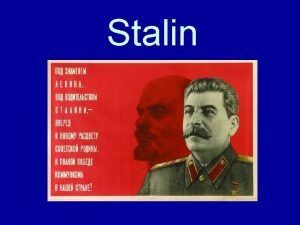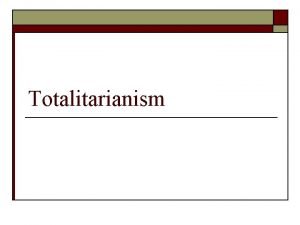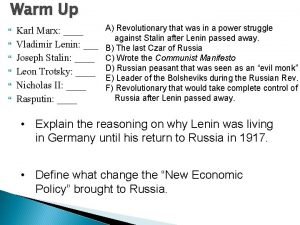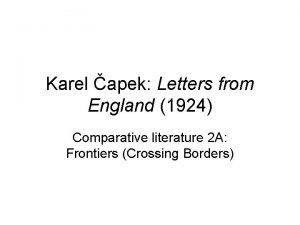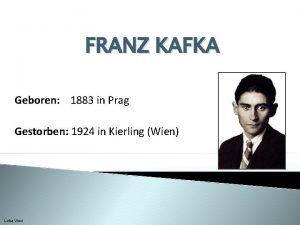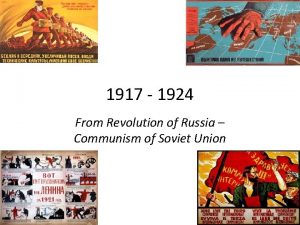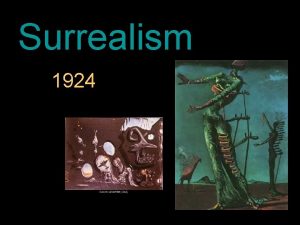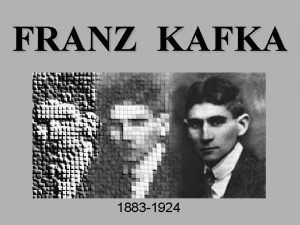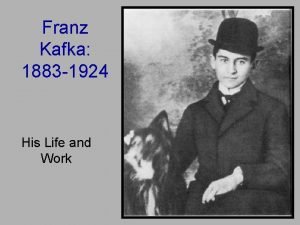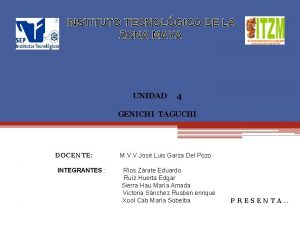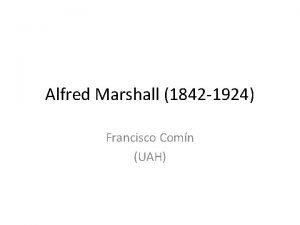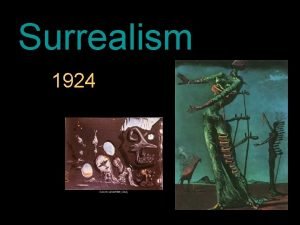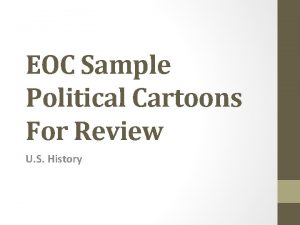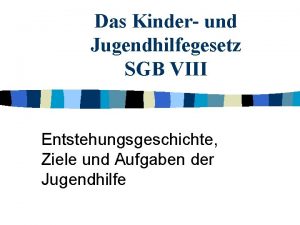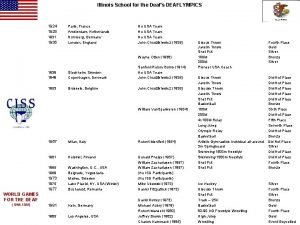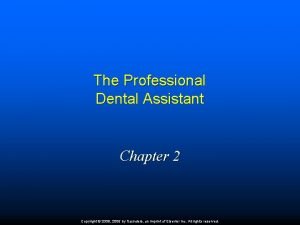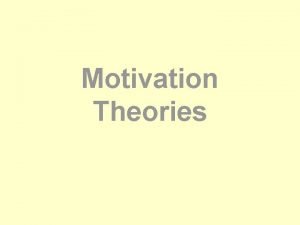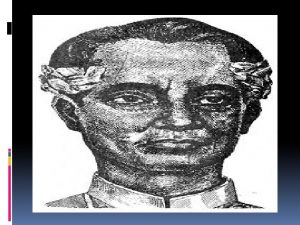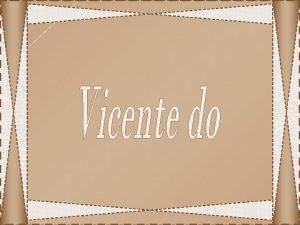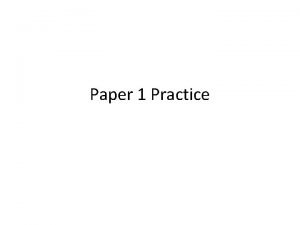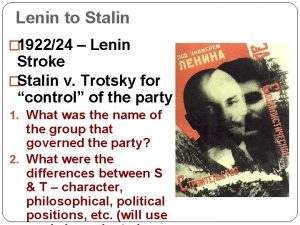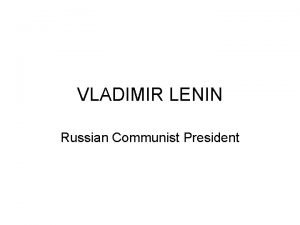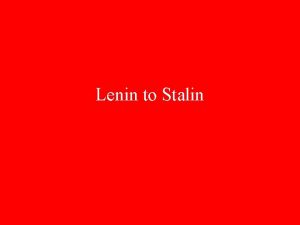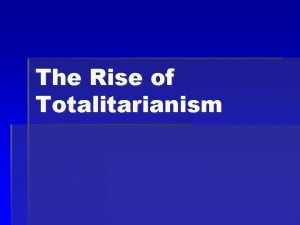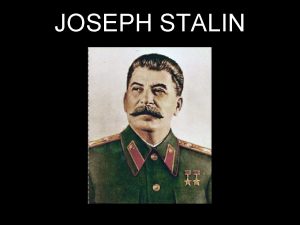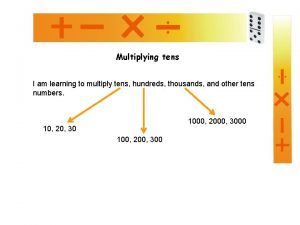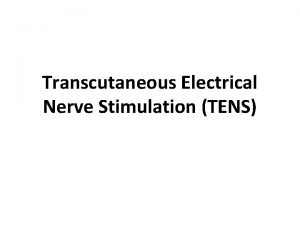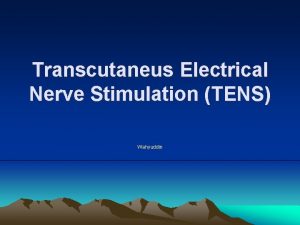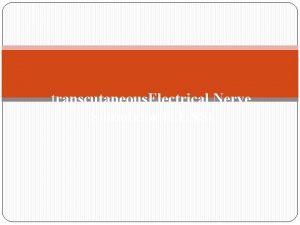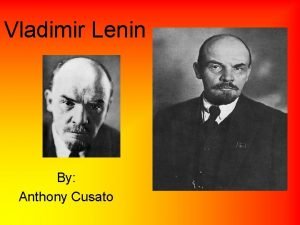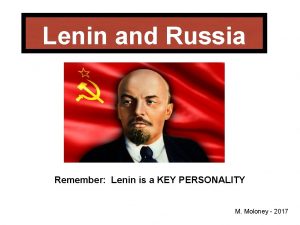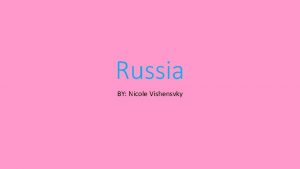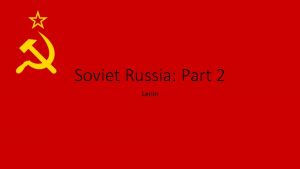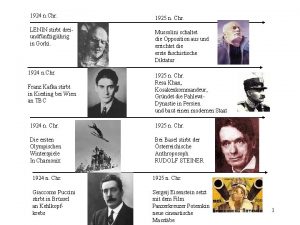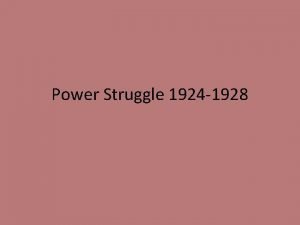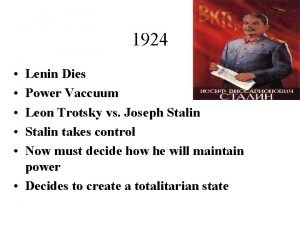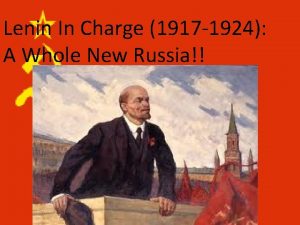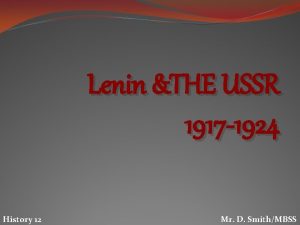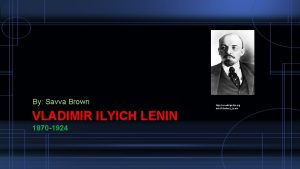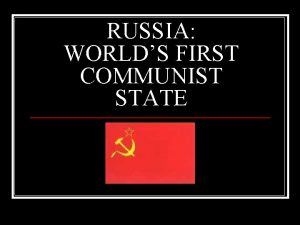FROM LENIN TO STALIN January 1924 tens of
























- Slides: 24

FROM LENIN TO STALIN • January 1924 – tens of thousands of people lined up in Moscow’s Red Square to view the body of Lenin. • They wanted Lenin preserved and put on permanent display. Lenin’s body would remain on display for more than 65 years.

STALIN • Stalin used ruthless measures to win dictatorial power and impose a new order on Russia. • His chief goal was to build a classless society in which the means of production were in the hands of the people.

GOVERNMENT • All political power, resources, and means of production would belong to workers and peasants. • In reality, the Communists party, not the people, reigned supreme. • Used secret police to enforce its will • Created the Union of Soviet Socialist Republics (USSR).

THE NEP • In 1921, Lenin adopted the New Economic Policy, or NEP. • It allowed some capitalist ventures. • While the state kept control of the banks, foreign trade, and large industries, small businesses were allowed to reopen for private profit. • Under the NEP, they held small plots of land freely sold their surplus crops. • NEP was a temporary retreat from communism. Stalin would soon put the Soviet Union back on the road to “pure” communism.

MAN OF STEEL Lenin’s sudden death in 1924 set off a power struggle among Communist leaders. Trotsky and Stalin were up against each other. Trotsky was a brilliant Marxist thinker, skillful speaker, and an architect of the Bolshevik Revolution. Stalin was a sharp political operator and behind -the-scenes organizer. • Lenin expressed grave doubts about Stalin’s ambitious nature. • To Lenin, Stalin was “too rude”.

THE FIVE-YEAR PLANS • Once in power, Stalin set out to make the Soviet Union into a modern industrial power. • Stalin proposed the first of several “five year plans” aimed at building heavy industry, improving transportation, and increasing farm output. • To achieve this economic growth, he brought all economic activity under government control.

COMMAND ECONOMY The Soviet Union developed a command economy, economy in which government officials made all basic economic decisions.

REVOLUTION IN AGRICULTURE • Stalin brought agriculture under government control. • Stalin forced peasants to give up their private plots and live on either state owned farms or on collectives (large farms owned by peasants as a group). • Peasants were allowed to keep their houses and personal belongings, but all farm animals and equipment had to be turned over to the collective. • The state set all prices and controlled access to farm supplies.

A RUTHLESS POLICY • Peasants resisted collectivization by killing farm animals, destroying tools, and burning crops. • Government responded with brutal force.

• Stalin targeted kulaks, or wealthy peasants, for special treatment. • The government confiscated kulaks’ land sent them to labor camps, where many thousands were executed or died from overwork. • Effects? • Collectivization took a horrendous toll. Angry peasants often grew just enough to feed themselves. In response, the government seized all the grain, leaving the peasants to starve. • Between 5 -8 million people died in the Ukraine alone. Millions more died in other parts of the Soviet Union.

THE GREAT PURGE • Even though Stalin’s power was absolute, he had obsessive fears that rival party leaders were plotting against him. • In 1934, he launched the Great Purge. • In this reign of terror, Stalin and his secret police cracked down especially on old Bolsheviks, party activists from the early days. • Soon he targeted army heroes, industrial managers, writers, and ordinary citizens.

THE GREAT PURGE • Between 1936 -1938, Stalin staged a series of spectacular public trials in Moscow. • During these “show trials” people confessed to all kinds of crimes, and these confessions were only made after hours of torture or to save family or friends. • About 800, 000 were executed. • Purges destroyed the older generation of revolutionaries. 90% of purges were the nation’s Military officers. This will come back to Haunt Stalin in 1941 when Nazi Germany Invades the Soviet Union.

FOREIGN POLICY • Russians wanted to guarantee their nation’s security by winning the support of other countries. • Sought to join the League of Nations & improve diplomatic trade relations with many western governments. • Western powers were highly suspicious of the Soviet Union because they were communists. • In the United States, fear of Bolshevik plots led to the Red Scare in the early 1920 s. • Britain broke off relations with the Soviet Union. • Eventually joined the League of Nations, but mistrust continued to poison relations, especially after the Great Purge.

LIFE IN A TOTALITARIAN STATE • Stalin’s propaganda mills created fatherly images of the Soviet leader. • Poets wrote hymns of praise about Stalin.

TOTALITARIAN CONTROL • Stalin turned the Soviet Union into a totalitarian state. • In this form of government, a one-party dictatorship attempts to regulate every aspect of the lives of its citizens. • To ensure obedience, obedience Stalin’s Communist party used secret police, censorship, and terror. • Police spies did not hesitate to open private letter or plant listening devices. Nothing appeared in print without official approval.

PROPAGANDA • Bombarded the public with relentless propaganda. • Radios and loud speakers blared into factories and villages. • In movies, theaters, and schools, citizens heard about communist successes and the evils of capitalism. • News proclaimed the misery of the workers in capitalist countries.

STALINIST PROPAGANDA REVIVED EXTREME NATIONALISM.

Those who supported Stalin’s aims were often glorified as heroes. • Example: A 14 year old boy was honored by the government because he turned his own father over to the secret police for associating with the kulaks.

WAR ON RELIGION • In accordance with the ideas of Marx, atheism became the official policy of the state. • Ceased most religious property and turned them into offices or museums. • Many religious leaders were killed.

CHANGES IN SOVIET SOCIETY • The new elite – At the head of society were members of the Communist party. • Social benefits and draw backs – free education, free medical care, day care for children, inexpensive housing, and public transportation were provided for all. • While the benefits were real, the standard of living remained low.

EDUCATION • After the Russian Revolution, the Communists built schools everywhere and required all children to attend. • School served important goals. • Educated workers were needed to build a modern industrial state. • In addition to basic skills, schools taught communist values, such as atheism, the glory of collective farming, and love of Stalin. <3 <3

WOMEN • Under communists, women won equality under the law. • They gained access to education and a wide range of jobs. • By the 1930 s, many Soviet women were working in medicine, engineering, or the sciences.

THE ARTS AND THE STATE “Art must serve politics” • Stalin forced writers and artists to conform to a style he called socialist realism. Its goal was to boost socialism by showing Soviet life in a positive light. • Censorship – Government controlled what books were published, what music was heard, and which works of art were put on display. • Under Stalin, writers, artists, and composers faced persecution.

LOOKING AHEAD Strict censorship, massive propaganda, and terror were instruments used by Stalin to ensure personal power and to push the Soviet Union toward modernization. By the time Stalin died in 1953, the Soviet Union was a world leader in heavy industry, steel, and oil production. http: //www. youtube. com/watch? v=Oachu 5 gl 7 Mo&safe=active
 1924 stalin becomes soviet dictator
1924 stalin becomes soviet dictator Lenin dies and stalin comes to power
Lenin dies and stalin comes to power Karl marx vladimir lenin and joseph stalin
Karl marx vladimir lenin and joseph stalin 1923 1924
1923 1924 Sportlarissa
Sportlarissa 1883-1924
1883-1924 Kafka expressionismus
Kafka expressionismus 1917 1924
1917 1924 1924-1953
1924-1953 Characteristics of surrealism
Characteristics of surrealism 1924-1883
1924-1883 Franz kafka geboren
Franz kafka geboren Genichi taguchi (1924-2012)
Genichi taguchi (1924-2012) Alfred marshall (1842-1924)
Alfred marshall (1842-1924) Persistence of memory art movement
Persistence of memory art movement Plenty for beautification political cartoon
Plenty for beautification political cartoon Reichsjugendwohlfahrtsgesetz 1924
Reichsjugendwohlfahrtsgesetz 1924 Deaflympics 1924
Deaflympics 1924 Chapter 2 the professional dental assistant
Chapter 2 the professional dental assistant Mayos theory
Mayos theory Ang dalawang uri ng pagtatalo
Ang dalawang uri ng pagtatalo Vicente do rêgo monteiro pieta
Vicente do rêgo monteiro pieta Lenin genocide
Lenin genocide Lenin hero
Lenin hero Ufaj ale sprawdzaj lenin
Ufaj ale sprawdzaj lenin
